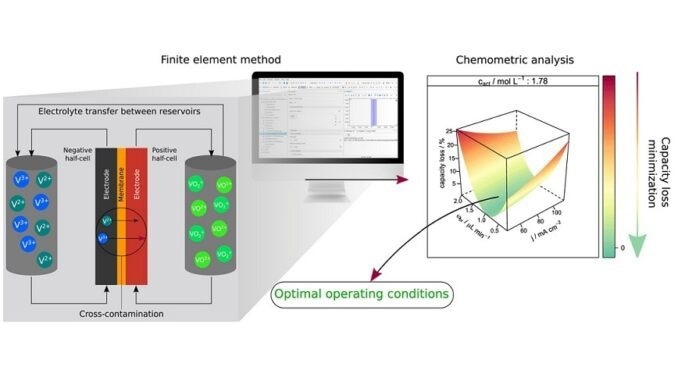Vanadium redox flow batteries, which can store a significant amount of energy and are used by a variety of industries, including electric power utilities, have a successful method for reducing charge capacity loss described in an article published by researchers at the Center for Development of Functional Materials (PDFF) in Brazil. The Chemical Engineering Journal published the article.
 The study involved computer simulations designed to find out how ion leakage between the anolyte and catholyte, called transport loss, leads to battery deactivation. Image Credit: CDMF.
The study involved computer simulations designed to find out how ion leakage between the anolyte and catholyte, called transport loss, leads to battery deactivation. Image Credit: CDMF.
The Federal University of São Carlos (UFSCar) in the state of São Paulo serves as the home of CDMF, a Research, Innovation, and Dissemination Center (RIDC), which is supported by FAPESP.
Computer simulations were used in the study to determine how transport loss—ion leakage between the anolyte and catholyte—causes battery deactivation and how to counteract it to maintain ion concentration over time. First, the researchers calculated how capacity loss was impacted by current density, concentration of active species, and volumetric flow.
To reduce capacity loss, the second stage looked for the best circumstances for the flow between electrolyte tanks in the opposite direction of cross-contamination, or the passage of electroactive species through the membrane.
The concentration of active species and current density were the primary factors influencing capacity loss. The researchers claim that by effectively reducing cross-contamination in various combinations of the two variables, their method offered the best possible flow between electrolyte tanks under various operating scenarios.
The primary benefit of redox flow batteries, according to the article’s last author and UFSCar professor Ernesto Pereira, is the absence of electrode aging because the electroactive components are dissolved in solutions rather than deposited onto electrodes.
Despite the small-scale nature of the study, commercial vanadium redox flow batteries should last longer than other types.
Energy efficiency loss due to aging is minimal, given the slow pace of aging.
Ernesto Pereira, Study Last Author and Professor, Federal University of São Carlos
The researchers clarified that, as part of a larger plan that also involves the creation of novel organic materials specifically for this type of battery, they are computationally investigating and evaluating flow batteries using existing batteries as a model.
Journal Reference:
Pilonetto, L. F., et al. (2023) Mitigating the capacity loss by crossover transport in vanadium redox flow battery: A chemometric efficient strategy proposed using finite element method simulation. The Chemical Engineering Journal. doi:10.1016/j.cej.2023.145336.